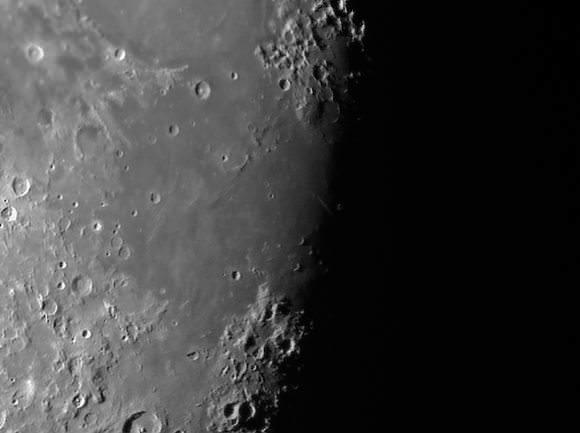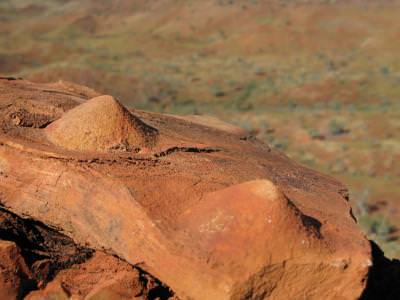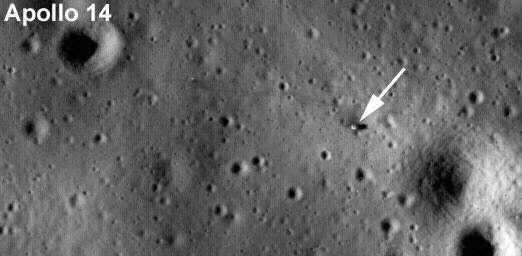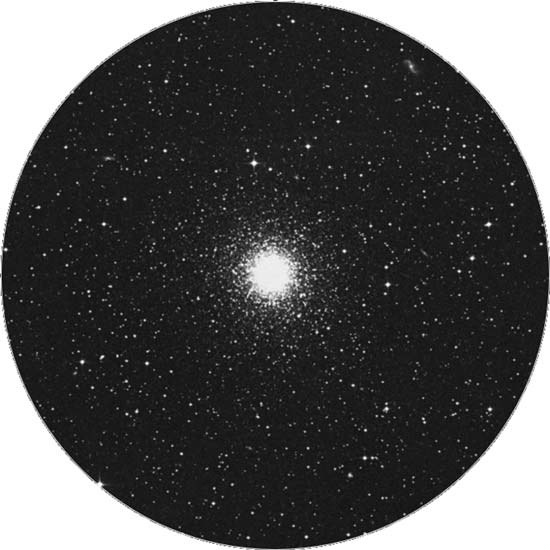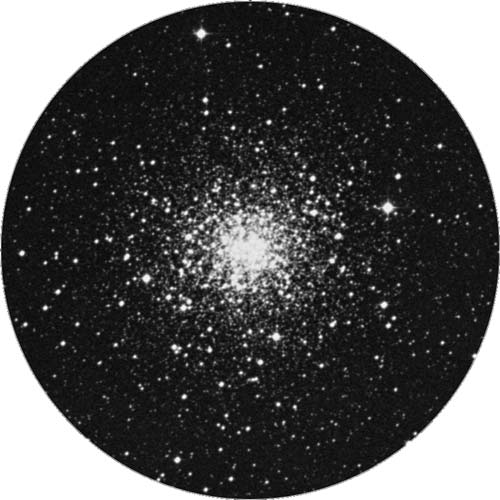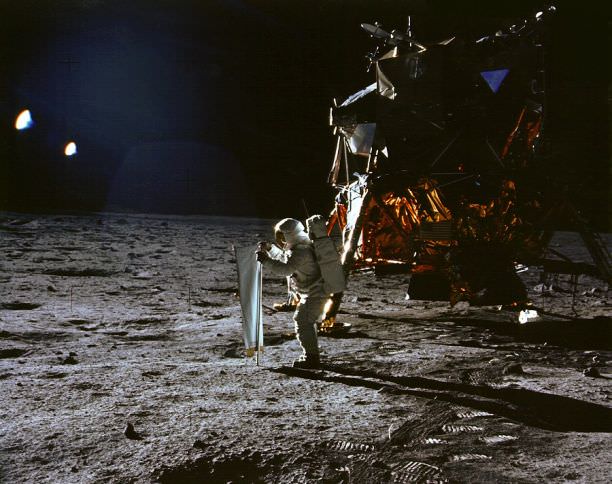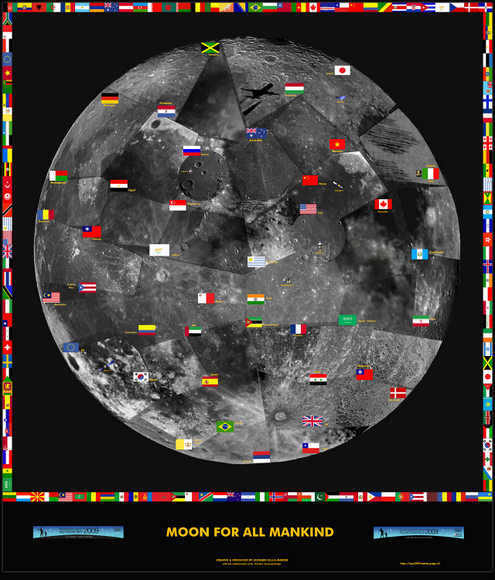Newscaster Walter Cronkite has passed away at the age of 92. He was admired and known for his enthusiastic coverage NASA’s space missions, from the early Mercury launches, through the ground-breaking Gemini missions, to the subsequent moon landings — which at times left him speechless — and the space shuttle program.
Continue reading ““That’s the Way It Is” — Apollo Supporter Walter Cronkite Dies”
Solar Cycle Triggers La Nina, El Nino-like Climate Shifts
[/caption]
Researchers have discovered a link between the 11-year solar cycle and tropical Pacific weather patterns that resemble La Niña and El Niño events.
When it comes to influencing Earth’s climate, the Sun’s variability pales in recent decades compared to greehouse gases — but the new research shows it still plays a distinguishable part.
The total energy reaching Earth from the sun varies by only 0.1 percent across the solar cycle. Scientists have sought for decades to link these ups and downs to natural weather and climate variations and distinguish their subtle effects from the larger pattern of human-caused global warming.
Co-authors Gerald Meehl and Julie Arblaster, both affiliated with the National Center for Atmospheric Research in Boulder, Colorado, analyzed computer models of global climate and more than a century of ocean temperature records. Arblaster is also affiliated with the Australian Bureau of Meteorology.
In the new paper and a previous one with additional colleagues, the researchers have been able to show that, as the sun’s output reaches a peak, the small amount of extra sunshine over several years causes a slight increase in local atmospheric heating, especially across parts of the tropical and subtropical Pacific where Sun-blocking clouds are normally scarce.
That small amount of extra heat leads to more evaporation, producing extra water vapor. In turn, the moisture is carried by trade winds to the normally rainy areas of the western tropical Pacific, fueling heavier rains.
As this climatic loop intensifies, the trade winds strengthen. That keeps the eastern Pacific even cooler and drier than usual, producing La Niña-like conditions.
“We have fleshed out the effects of a new mechanism to understand what happens in the tropical Pacific when there is a maximum of solar activity,” Meehl said. “When the sun’s output peaks, it has far-ranging and often subtle impacts on tropical precipitation and on weather systems around much of the world.”
The result of this chain of events is similar to a La Niña event, although the cooling of about 1-2 degrees Fahrenheit is focused further east and is only about half as strong as for a typical La Niña.
True La Niña and El Nino events are associated with changes in the temperatures of surface waters of the eastern Pacific Ocean. They can affect weather patterns worldwide.
Although the Pacific pattern in the new paper is produced by the solar maximum, the authors found that its switch to an El Niño-like state is likely triggered by the same kind of processes that normally lead from La Niña to El Niño.
The transition starts when the changes of the strength of the trade winds produce slow-moving off-equatorial pulses known as Rossby waves in the upper ocean, which take about a year to travel back west across the Pacific.
The energy then reflects from the western boundary of the tropical Pacific and ricochets eastward along the equator, deepening the upper layer of water and warming the ocean surface.
As a result, the Pacific experiences an El Niño-like event about two years after solar maximum — also about half as strong as a true El Niño. The event settles down after about a year, and the system returns to a neutral state.
“El Niño and La Niña seem to have their own separate mechanisms,” Meehl said, “but the solar maximum can come along and tilt the probabilities toward a weak La Niña. If the system was heading toward a La Niña anyway,” he adds, “it would presumably be a larger one.”
The study authors say the new research may pave the way toward predictions of temperature and precipitation patterns at certain times during the approximately 11-year solar cycle.
In an email, Meehl noted that previous work by his team and other research groups has shown that “most of the warming trend in the first half of the 20th Century was due to an increasing trend of solar output, while most of the warming trend in the last half of the 20th Century and ever since has been due to ever-increasing GHG (greenhouse gas) concentrations in the atmosphere from the burning of fossil fuels.”
The new paper appears this month in the Journal of Climate, a publication of the American Meteorological Society. (Sorry, it’s not yet available online.)
Source: Eurekalert
Ancient Domes Reveal 3.45-billion-year-old Life History
[/caption]
Ancient, dome-like rock structures contain clues that life was active on Earth 3.45 billion years ago, according to new research — and the findings could help shed light on life’s history on Earth and other planets, including Mars.
Abigail Allwood, who studies planetary habitability at NASA’s Jet Propulsion Laboratory, led the research. She and her colleagues studied stromatolites, which are dome- or column-like sedimentary rock structures formed in shallow water, layer by layer, over long periods of geologic time.
Geologists have long known that the large majority of the relatively young stromatolites they study—those half a billion years old or so—have a biological origin; they’re formed with the help of layers of microbes that grow in a thin film on the seafloor.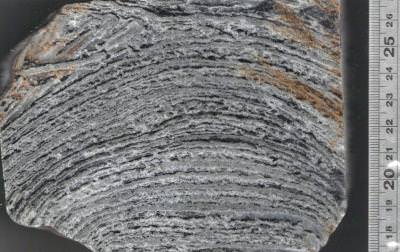
The microbes’ surface is coated in a mucilaginous substance to which sediment particles rolling past get stuck.
“It has a strong flypaper effect,” said John Grotzinger, a Caltech geologist and a study co-author. In addition, the microbes sprout a tangle of filaments that almost seem to grab the particles as they move along. “The end result,” Grotzinger explains, “is that wherever the mat is, sediment gets trapped.”
So in a young stromalite, dark bands like those seen in the close-up cross section at left indicate organic material. But 3.45 billion years ago, in the early Archean period of geologic history, things weren’t quite so simple.
“Because stromatolites from this period of time have been around longer, more geologic processing has happened,” Grotzinger says. Pushed deeper toward the center of Earth as time went by, these stromatolites were exposed to increasing, unrelenting heat. This is a problem when it comes to examining the stromatolites’ potential biological beginnings, he explains, because heat degrades organic matter. “The hydrocarbons are driven off,” he says. “What’s left behind is a residue of nothing but carbon.”
As such, geologists debate whether or not the carbon found in these ancient rocks is diagnostic of life.
Allwood and her team turned to the texture and morphology of the rocks themselves, from samples gathered in Western Australia. The samples, says Grotzinger, were “incredibly well preserved.” Dark lines of what was potentially organic matter were “clearly associated with the lamination, just like we see in younger rocks. That sort of relationship would be hard to explain without a biological mechanism.”
Allwood set about trying to find other types of evidence. She looked at what she calls the “microscale textures and fabrics in the rocks, patterns of textural variation through the stromatolites and—importantly—organic layers that looked like actual fossilized organic remnants of microbial mats within the stromatolites.”
She saw “discrete, matlike layers of organic material that contoured the stromatolites from edge to edge, following steep slopes and continuing along low areas without thickening.” She also found pieces of microbial mat incorporated into storm deposits, which disproved the idea that the organic material had been introduced into the rock more recently, rather than being laid down with the original sediment.
“In addition,” Allwood notes, “Raman spectroscopy showed that the organics had been ‘cooked’ to the same burial temperature as the host rock, again indicating the organics are not young contaminants.”
Allwood said she, Grotzinger, and their team have collected enough evidence that it’s no longer a great leap to accept the stromatolites as biological in origin. And the researchers say the implications of the findings don’t stop at life on Earth.
“One of my motivations for understanding stromatolites,” Allwood says, “is the knowledge that if microbial communities once flourished on Mars, of all the traces they might leave in the rock record for us to discover, stromatolite and microbial reefs are arguably the most easily preserved and readily detected. Moreover, they’re particularly likely to form in evaporative, mineral-precipitating settings such as those that have been identified on Mars. But to be able to interpret stromatolitic structures, we need a much more detailed understanding of how they form.”
Both images courtesy of Abigail Allwood.
Source: Eurekalert, a media service of the American Association for the Advancement of Science (AAAS). The research appeared in online June 10 and in print June 16 in the Proceedings of the National Academy of Sciences (PNAS).
LRO Images Apollo Landing Sites (w00t!)
[/caption]
As anticipated, NASA released images of the Apollo landing sites taken by the Lunar Reconnaissance Orbiter (LRO). The pictures show the Apollo missions’ lunar module descent stages sitting on the moon’s surface, as long shadows from a low sun angle make the modules’ locations evident. Also visible are the tracks left where the astronauts walked repeatedly in a “high traffic zone” and perhaps by the Modularized Equipment Transporter (MET) wheelbarrow-like carrier used on Apollo 14. Wow.
As a journalist, I (most of the time) try to remain objective and calm. But there’s only one response to these images: W00T!
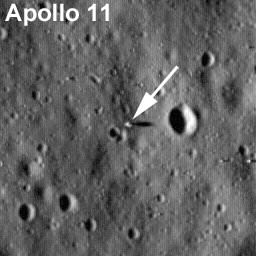
These first images were taken between July 11 and 15, and the spacecraft is not yet in its final mapping orbit. Future LROC images from these sites will have two to three times greater resolution.
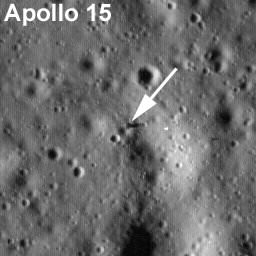
These images are the first glimpses from LRO,” said Michael Wargo, chief lunar scientist, NASA Headquarters, Washington. “Things are only going to get better.”
The Japanese Kaguya spacecraft previously took images of some of the Apollo landing sites, but not at a high enough resolution to show any of the details of the lander or any other details. But here on these images, the hardware is visible. “It’s great to see the hardware on the surface, waiting for us to return,” said Mark Robinson, principal investigator for LRO.
Robinson said the LROC team anxiously awaited each image. “We were very interested in getting our first peek at the lunar module descent stages just for the thrill — and to see how well the cameras had come into focus. Indeed, the images are fantastic and so is the focus.”
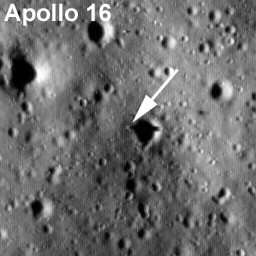
The Lunar Reconnaissance Orbiter Camera, or LROC, was able to image five of the six Apollo sites, with the remaining Apollo 12 site expected to be photographed in the coming weeks.
The spacecraft’s current elliptical orbit resulted in image resolutions that were slightly different for each site but were all around four feet per pixel. Because the deck of the descent stage is about 12 feet in diameter, the Apollo relics themselves fill an area of about nine pixels. However, because the sun was low to the horizon when the images were made, even subtle variations in topography create long shadows. Standing slightly more than ten feet above the surface, each Apollo descent stage creates a distinct shadow that fills roughly 20 pixels.
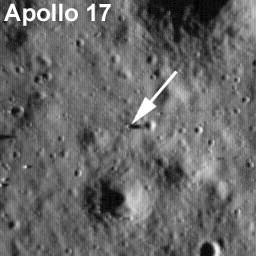
The image of the Apollo 14 landing site had a particularly desirable lighting condition that allowed visibility of additional details. The Apollo Lunar Surface Experiment Package, a set of scientific instruments placed by the astronauts at the landing site, is discernable, as are the faint trails between the module and instrument package left by the astronauts’ footprints.
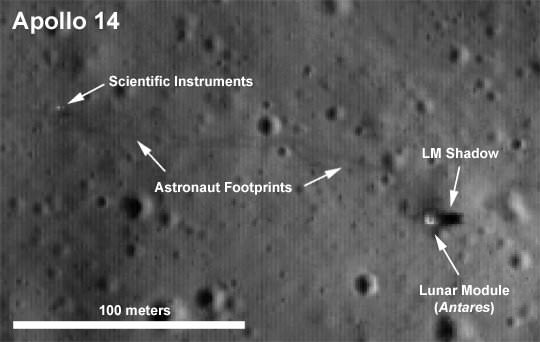
Source: NASA
Chandrayaan-1 Rescued from Failure
[/caption]
The Chandrayaan 1 spacecraft, India’s moon orbiting satellite was almost lost earlier this year, Indian Space Research Organization revealed, as the star tracking system overheated and malfunctioned. The system helps determine and maintain the spacecraft’s orientation. Engineers were able to patch in the gyroscopes and another instrument to help maneuver the spacecraft, but they are not sure how long this jury-rigged system will work. At this point, determining the spacecraft’s future might be difficult, and differing statements from various officials reflect that.
“We are not sure how long we will be able to sustain it. The life of Chandrayaan-I designed for two years may be reduced,” said ISRO spokesman S. Satish.
ISRO chief Madhavan Nair said the star tracking system cannot be recovered, but he dismissed suggestions that the sensor’s failure might reduce the life span of the spacecraft.
“The life (of the spacecraft) is not dependent on this instrument. This instrument is used only for orientation of the spacecraft,” he said. “The sensor cannot be recovered at this stage and we hope that the remaining part of this mission will be completed.”
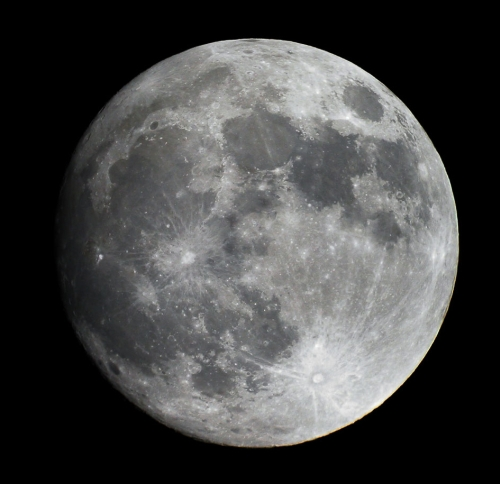
Chandrayaan-1 launched in October 2008 and suffered from overheating shortly after it began operations in lunar orbit in November, but the ISRO was able to change the spacecraft’s orientation and cut down on the amount of time the instruments were used to compensate.
In May 2009, however, officials unexpectedly raised the orbit of the spacecraft. At that time officials said they had completed mission objectives from 100 km above the moon and raised the height of the spacecraft to 200 km to enable imaging lunar surface with a wider swath. But reports say that May is when the star tracker system malfunctioned, as well.
Nair said the star sensor is suspected to have failed because of “excessive radiation” from the Sun. He said gyroscopes are not susceptible for the kind of radiation that the sensor was subjected to. “So, we hope it will survive the remaining mission duration”.
He added more than 90 percent of the two-year mission’s objectives have already been achieved.
ISRO Scientists hope the Chandrayaan project will boost India’s capacity to build more efficient rockets and satellites, especially through miniaturization, and open research avenues for young Indian scientists. India plans to follow the Chandrayaan, which means “moon craft” in Sanskrit, by landing a rover on the moon in 2011.
Source: The Hindu
Weekend SkyWatcher’s Forecast: July 17-19, 2009
Greetings, fellow SkyWatchers! It’s a picturesque weekend to get up early as the Moon heads for the Pleiades and on towards a close encounter with Venus. With plenty of dark skies to go around and the random meteor rate a little higher than usual, why not spend some time with the constellation of Lupus? No telescope or binoculars? No problem. There’s also plenty of things to do over the next few days that only requires just your eyes and a little knowledge of the skies. I’ll see you in the backyard…
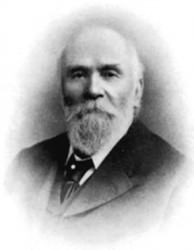 Friday, July 17, 2009 – This date marks the 1904 passing of Isaac Roberts, an English astronomer who specialized in photographing nebulae. Since many deep sky objects are far too faint to be seen with the human eye, photography soon became a great way of studying them, but as the Earth moved, long exposure photography became problematic as the image also moved and blurred. Roberts’ developed a telescope/camera combination which would track, allowing for a long exposure times and perfected images. As an ironic twist, this is also the date on which a star was first photographed at Harvard Observatory!
Friday, July 17, 2009 – This date marks the 1904 passing of Isaac Roberts, an English astronomer who specialized in photographing nebulae. Since many deep sky objects are far too faint to be seen with the human eye, photography soon became a great way of studying them, but as the Earth moved, long exposure photography became problematic as the image also moved and blurred. Roberts’ developed a telescope/camera combination which would track, allowing for a long exposure times and perfected images. As an ironic twist, this is also the date on which a star was first photographed at Harvard Observatory!
Tonight let’s have a look at a real little power punch globular cluster located in northern Lupus— NGC 5824. Although it’s not an easy star hop, you’ll find it about 7 degrees southwest of Theta Librae,
and exactly the same distance south of Sigma Librae (RA 15 03 58 Dec –33 04 04). Look for a 5th magnitude star in the finderscope to guide you to its position southeast.
As a Class I globular cluster, you won’t find any others that are more concentrated than this. Holding a rough magnitude of 9, this little beauty has a deeply concentrated core region that is simply unresolvable. Discovered by E.E. Barnard in 1884, it enjoys its life in the outer fringes of its galactic halo about 104 light-years away from Earth and contains many recently discovered variable stars. Oddly enough, this metal-poor globular may have been formed by a merger. Research on GC 5824’s stellar population leads us to believe that two less dense and differently aged globulars may have approached one another at a low velocity and combined to form this ultra-compact structure. Be sure to mark your observing notes on this one! It also belongs to the Bennett catalog and is part of many globular cluster lists.
Saturday, July 18, 2009 – Celestial scenery alert! Get up before dawn to witness the Moon graze by the Pleiades. For some observers, the pair will be separated by around half a degree; it will be an occultation event for others. Still not enough? Then be sure to look for the twin red pair of Mars and Aldebaran spaced equidistant to the Moon’s south!
 Tonight let’s begin with the 1689 birth of Samuel Molyneux. This British astronomer and his assistant were the first to measure the aberration of starlight. What star did they choose? Alpha Draconis, which oscillated with an excursion of 39’’ from its lowest declination in May. Why choose a single star during an early dark evening? Because Alpha Draconis—Thuban—is far from bright. At magnitude 3.65, Thuban’s ‘‘alpha’’ designation must have come from a time when it, not Polaris, was the northern celestial pole star. If you’re aware that the two outer stars of the ‘‘dipper’’ point to Polaris, then use the two inner stars to point to Thuban (RA 14 04 23 Dec +64 22 33). This 300-light-year distant white giant star is no longer main sequence, a rare binary type.
Tonight let’s begin with the 1689 birth of Samuel Molyneux. This British astronomer and his assistant were the first to measure the aberration of starlight. What star did they choose? Alpha Draconis, which oscillated with an excursion of 39’’ from its lowest declination in May. Why choose a single star during an early dark evening? Because Alpha Draconis—Thuban—is far from bright. At magnitude 3.65, Thuban’s ‘‘alpha’’ designation must have come from a time when it, not Polaris, was the northern celestial pole star. If you’re aware that the two outer stars of the ‘‘dipper’’ point to Polaris, then use the two inner stars to point to Thuban (RA 14 04 23 Dec +64 22 33). This 300-light-year distant white giant star is no longer main sequence, a rare binary type.
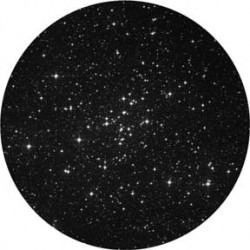 Now head to binary Eta Lupi, a fine double star resolvable with binoculars. You’ll find it by staring at Antares and heading due south two binocular fields to center on bright H and N Scorpii—then one binocular field southwest. Now hop 5 degrees southeast (RA 16 25 18 Dec – 40 39 00) to encounter the fine open cluster NGC 6124. Discovered by Lacaille, and known as object I.8, this 5th magnitude open cluster is also Dunlop 514, Melotte 145, and Collinder 301. Situated about 19 light years away, it shows a fine, round, faint spray of stars to binoculars and is resolved into about 100 stellar members to larger telescopes. Although NGC 6124 is low for northern observers, it’s worth the wait to try at culmination. Be sure to mark your notes because this delightful galactic cluster is also a Caldwell object and counts for a southern skies binocular award.
Now head to binary Eta Lupi, a fine double star resolvable with binoculars. You’ll find it by staring at Antares and heading due south two binocular fields to center on bright H and N Scorpii—then one binocular field southwest. Now hop 5 degrees southeast (RA 16 25 18 Dec – 40 39 00) to encounter the fine open cluster NGC 6124. Discovered by Lacaille, and known as object I.8, this 5th magnitude open cluster is also Dunlop 514, Melotte 145, and Collinder 301. Situated about 19 light years away, it shows a fine, round, faint spray of stars to binoculars and is resolved into about 100 stellar members to larger telescopes. Although NGC 6124 is low for northern observers, it’s worth the wait to try at culmination. Be sure to mark your notes because this delightful galactic cluster is also a Caldwell object and counts for a southern skies binocular award.
 Sunday, July 19, 2009 – Want a picturesque sight before dawn? Then look for the close pairing of Venus and the Moon. Which has the greater crescent? This probably would have interested Edward Charles Pickering, who was born on this date in 1864. Pickering was the director of Harvard College Observatory for 42 years and published the first all-sky photographic map in 1902. While at Harvard, he recruited many women to work for him, including Annie Jump Cannon, Henrietta Swan Leavitt, and Antonia Maury. These women were called “Pickering’s Harem” by the scientific community – but don’t you believe any crap for one instant. In those days, it was incredibly difficult for a woman to have her academic work recognized and Edward Pickering was one of the very few men open-minded enough to realize just what these women astronomers could achieve and allow them the chance to do it!
Sunday, July 19, 2009 – Want a picturesque sight before dawn? Then look for the close pairing of Venus and the Moon. Which has the greater crescent? This probably would have interested Edward Charles Pickering, who was born on this date in 1864. Pickering was the director of Harvard College Observatory for 42 years and published the first all-sky photographic map in 1902. While at Harvard, he recruited many women to work for him, including Annie Jump Cannon, Henrietta Swan Leavitt, and Antonia Maury. These women were called “Pickering’s Harem” by the scientific community – but don’t you believe any crap for one instant. In those days, it was incredibly difficult for a woman to have her academic work recognized and Edward Pickering was one of the very few men open-minded enough to realize just what these women astronomers could achieve and allow them the chance to do it!
Tonight for unaided observers, let’s begin by identifying Zeta Ophiuchi, the centermost in a line of stars marking the edge of the constellation of Ophiuchus, about a handspan north of Antares. As a magnificent 3rd magnitude blue-white Class O, this hydrogen-fusing dwarf is eight times larger than our own Sun. Hanging out some 460 light-years away, it is dulled by the interstellar dust of the Milky Way and would shine two full magnitudes brighter if it were not obscured. Zeta is a ‘‘runaway star’’—a product of a one-time supernova event of a double-star system. Now roughly halfway through its 8 million-year life span, the same fate awaits this star! Nowpoint binoculars or small scopes about three finger-widths south to have a look at Phi Ophiuchi. This is a spectroscopic double star, but it has several delightful visual companions!
Almost in between these two bright stars is our telescopic target for tonight—M107. Discovered by Pierre Mechain in 1782, and added to the catalog in 1947, it’s probably one of the last of the Messier objects to be discovered and wasn’t resolved into individual stars until studied by Herschel in 1793.
M107 isn’t the most impressive of globulars, but this Class X is notable as a faint, diffuse area with a core region in binoculars and is surprisingly bright in a small telescope. It’s a curious cluster, for some believe it contains dark, dust-obscured areas, which make it unusual. Located around 21,000 lightyears away, this little beauty contains around 25 known variable stars. Visually, the cluster begins to resolve around the edges to mid-aperture, and the structure is rather loose. If sky conditions permit, the resolution of individual chains at the globular’s edges makes this globular well worth a visit!
This week’s awesome images are (in order of appearance): Isaac Roberts (historical image), NGC 5824, Alpha Draconis, NGC 6124 (credit—Palomar Observatory, courtesy of Caltech), Edward Pickering (historical image) and M107 (credit—Palomar Observatory, courtesy of Caltech). We thank you so much!
Watch the STS-127 Launch Video in HD
The storm clouds stayed far enough away so that space shuttle Endeavour and her STS-127 crew finally launched on July 15 on its sixth attempt. The video here shows spectacular views, from the camera mounted on the shuttle’s external tank, showing the launchpad dropping away below, and then the separation of the shuttle’s twin boosters two minutes and five seconds into the flight. Watching the video here, multiple pieces of foam insulation can be seen falling away from the external tank during the early moments of flight. The crew is working today on heat shield inspections to see if any significant damage occurred from any foam strikes on the belly of the orbiter.
Continue reading “Watch the STS-127 Launch Video in HD”
Apollo 11 Anniversary Link-O-Rama
The Apollo 11 40th anniversary is coming at us fast and furious! With restored images and video, mission audio, interviews, and special features, who can keep track of it all? Well, we’re going to try. We’ll post here all the links we can find that has anything to do with the anniversary. If you find something of interest elsewhere you think we should add, email it to Nancy or post it in the comments, and we’ll add it. This will be Apollo 11 anniversary HQ!
Audio, Video, etc:
Listen to Apollo 11 mission audio “live” to the minute as it happened 40 years ago (July 16-24) or listen later at any time: We Choose the Moon
High-Definition Restored Apollo 11 Video from NASA
Read the transcriptions of the recorded audio
Find other recordings and transcriptions here.
Video from INA French television’s broadcasts from July 1969
IYA Malta’s Moon for All Mankind video
Cool websites:
NASA’s Apollo 11 40th Anniversary website
NASA’s Apollo Missions website
NASA’s Interactive Tranquility Base
NASA’s Apollo Lunar Surface Journals
Detailed Summaries of the Apollo missions
The Smithsonian National Air and Space Museum’s Apollo 11 site
The Boston Globe’s Big Picture does Apollo 11
Discovery News Apollo 11 Slideshow
Dramatic panoramas of the Apollo landing sites.
Miscellaneous:
Free online book from the National Acadamies Press:
[/caption] The engineers who helped beam images of the lunar surface to Earth in 1969 are doing a little hand-wringing these days – because original film of the historic event got recycled at NASA rather than preserved. Still, the agency has teamed up with a Hollywood restoration team to collect and improve on backup copies of the Apollo 11 feat. The clearer, digitized versions will be available in a few months.
Dick Nafzger, a NASA engineer at Goddard Space Flight Center who oversaw television production of Apollo 11, said the initial tape was stored in the national archives until the Apollo program no longer needed the data it contained. Sometime after that, NASA thinks, the tapes were pulled from their boxes, erased and used to record data for subsequent missions. It wasn’t until years later that Nafzger and others understood the historical value of the tapes — and the gravity of their loss. “When I was a 28-year-old engineer, maybe I didn’t understand that. But I certainly do now,” said Nafzger, who spoke at a NASA press conference on Thursday. He hastened to add that he wasn’t in the loop when the tapes were being erased; he and others discovered the tapes’ fate only later, when they became interested in improving the notoriously grainy footage. Because backup tapes of the mission weren’t so readily discarded after the celebrated lunar landing on July 20, 1969, the engineer-turned-historian has been given another chance. Nafzger was joined at the press conference by Stan Lebar, the now-retired Westinghouse electric program manager who spearheaded the lunar camera, and Mike Inchalik, president of Lowry Digital in Burbank, California. Together, the men have managed to secure tapes from Sydney, Australia and the archives at CBS, where the live footage was streamed from Houston on that monumental day. They’re bringing the best of digital technology to bear on what was at the time the cutting edge of videography, even though it was made harder on the eyes of television audiences by conversion to broadcast form. For restoration purposes, the original footage that’s been recovered is actually quite useful, Inchalik said. “Every frame in that sequence has some information that it shares with others … if you can extract what doesn’t belong, you can make those pictures clearer,” he said. The team showed four short clips from the $230,000 restoration project at the press conference — including moments where both Neil Armstrong and Buzz Aldrin first set foot on the lunar surface. The “after” images are indeed clearer, with more accurate lightning and sharper contrast. Inchalik said his company is sensitive to preserving the historical integrity of the footage, and aware that any missteps could fuel conspiracy theories that the lunar landing was faked. “There are elements in the original where we’re not touching or making corrections we would normally make,” he said. “There’s some value in the fact that we’re not a special effects house; we’re a restoration house.” Nafzger was careful to point out that no new footage will be issued of the landing; all the restored tape comes from video that has already been released. The final product is expected in September. [/caption] The archipelago of Malta has coordinated a global campaign to take images of sections of the Moon’s surface as seen from 40 countries, and combine them in this commemorative, symbolic whole called the “Moon for All Mankind.” The composite was released today, which marks the 40th anniversary of the Apollo 11 launch. Monday will be the anniversary of the landing. Update: The Malta IYA Committee wrote to share this link with UT readers — a really fascinating animation they created. Check it out!
On the composite, the United States was assigned the region of the Sea of Tranquility, the location of the Apollo 11 landing on July 20, 1969. The U.S. image was provided by amateur astronomer Mark Sibole of Fife Lake, Michigan, the builder and operator of Mark’s Tin Shed Observatory (MTSO). The image was captured on June 12, 2009, using Meade LX200R 10-inch telescope and a DSI PRO III imager. The final composition is a stack of 100 images at 0.14 seconds autostacked in Envisage. “I’ve done many lunar images, but this is the first time that I set out to zero in on one specific area,” Sibole said. “Everyone wants to ‘capture’ the Moon, and I’m pretty happy with the result.” Besides Apollo 11, the image commemorates the International Year of Astronomy 2009 (IYA2009), as well as the 50th anniversary of the first robotic lunar landing by the Russian Luna 2 probe. Other countries to have launched spacecraft to the Moon include Japan, Europe, China and India; these probes are also featured in the image. Most of the images were taken during the May or June full moons of 2009 but some were older, and Italy’s was a four hundred year-old sketch by Galileo Galilei. Malta is an archipelago of small islands in the Mediterranean with a population of just over 400,000 people. It has a rich history and is home to the oldest free-standing stone structures in the world. It is claimed that these temples, which are thousands of years old, were aligned to the solstice and so there has been a strong astronomical tradition in Malta for many centuries. Source: IYA2009, via the American Astronomical Society (AAS) press wire. To find out more about Mark Sibole and his observatory on the Web, visit astronomy.qteaser.com.NASA Laments Missing Apollo 11 Film, Makes Do With What’s Left
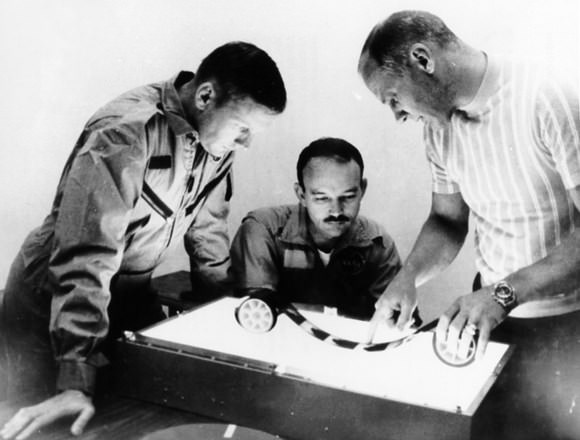
Moon For All Mankind
